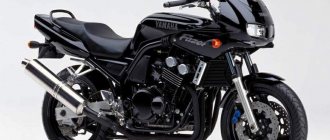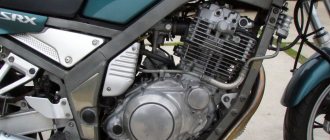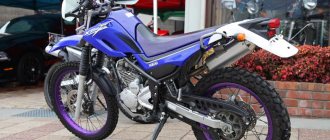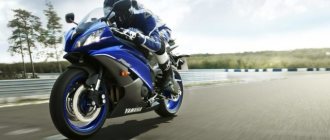The Yamaha XJR 400 is a classic road motorcycle, distinguished by its reliability and simplicity of design. Produced between 1993 and 2007. During this time it has undergone several modifications (3 generations).
The road worker is equipped with a 400 cc air-oil-cooled engine. see, manual 6-speed gearbox, OHLINS shock absorbers, Brembo brakes. This model is especially popular in the Japanese domestic market. The secret of success lies in its reliability and relatively low price.
The XJR 400 R is perfect for everyday trips around the city and for covering medium distances up to 500 km.
This motorcycle is a workhorse that copes with its tasks perfectly, requires a minimum of effort and maintenance costs, and most importantly does not let you down in difficult times and makes its rider happy every day.
The closest competitors are Honda CB 400 Super Four, Suzuki Bandit 400.
Technical characteristics of Yamaha XJR 400 R
- type - classic road motorcycle, street, classic, city bike.
- a country .
Engine:
- working volume - 400 cubic meters. cm (399 cm3).
- 4 cylinder, four stroke.
- maximum power - 39.5 kW = 53 hp. at 11000 rpm.
- torque - 35 Nm at 9500 rpm.
- bore/stroke: 55 mm x 42 mm.
- Timing - DOHC, 4 valves per cylinder, 2 upper shafts with chain drive.
- The operating order of the cylinders is 1-2-4-3.
- compression ratio - 10.7:1.
- ignition control - transistor with throttle position sensor.
- cooling system – air-oil.
- fuel supply system – carburetor without pump.
- carburetors - 4 x Mikuni BSR30 constant vacuum (CV type).
- type of lubrication system - wet sump and full-flow cleaning.
- starting system – electric starter.
Transmission, chassis, brake system:
- gearbox - manual, 6 steps.
- clutch - multi-plate in an oil bath.
- drive - chain.
- frame - duplex steel made of radial pipes.
- front suspension - telescopic fork.
- rear suspension - pendulum type with two "backpack" type shock absorbers from OHLINS, adjustable for preload.
- The angle of inclination/reach of the front fork is 26 degrees/99 mm.
- Brembo brake system (1996-1999), two-piston calipers.
- front brakes are double discs 2×298 mm.
- rear brakes - single disc, disc diameter 245 mm.
Dimensions:
- length - 2085 mm.
- width - 735 mm.
- height - 1085 mm.
- seat height – 780 mm.
- wheelbase - 1435 mm.
- minimum clearance - 115 mm.
- dry weight – 177 kg.
Wheels:
- wheels - alloy wheels, tubeless tires.
- front tire size - 110/70-17
- rear tire size - 150/60-17
Electrical equipment and lighting:
- battery type/dimensions - YTX9-BS (12 V, 8 Ah, 80 A)/152x88x110 mm.
- headlight lamp - halogen, 12 V, 60/55 W, H4 base.
- taillight lamps - 12 V, 21/5 W.
- direction indicator lamps - 12 V, 21 W.
Other information:
- gas tank volume – 20 liters.
- fuel type - gasoline AI-92 and higher.
- average fuel consumption (in the combined cycle) is about 5 liters per 100 km.
- acceleration from 0 to 100 km/h - about 4-5 seconds.
- maximum speed - 180 km/h (112 mph).
Yamaha SR400 design
The year of production began determined the material.
Front fork with corrugations.
Rear shock absorber with open spring.
Most of the bike's parts, from the frame to the suspension, were made of steel . a duplex scheme was used .
The stock suspension setup is simple - a telescopic fork for the front wheel with a travel of 105 mm and a stay diameter of 35 mm , a pair of shock absorbers on a pendulum for the rear. Their working stroke was longer - 150 mm .
The only nod to modernity was the ability to adjust the preload in the rear . You can set one of five fixed positions.
The highlights of the model are the transparent right engine cover and an additional button for controlling the standard decompressor, located on the left steering wheel. Both were supposed to help start the engine.
Exterior
For many, it is the exterior of this model that is the decisive reason for purchase, because now it is quite difficult to find a “real” motorcycle without unnecessary plastic and wires.
As bikers say, the SR400 is a motorcycle for real men. Everything is iron, except for two decorative triangular trims on the sides between the rear wheel and the engine.
A characteristic feature of the exterior is the abundance of chrome
Chrome plated shock absorber springs.
Chrome plated brake foot.
Chromed passenger handle.
Chromed gas tank cap.
Front end
For a user who has at least once seen domestic Java, the front panel does not raise any questions.
Within the framework of retro classics, this motorcycle is simply perfect.
- The large fender fits tightly against the 18-inch spoked wheel. The fork stays along it are covered with covers; above, up to the headlight mount, they are covered with corrugated tubes.
- Headlight large, round. The low and high beams are output to different filaments. The instrument panel cups rest on it. There is no windshield, but based on user reviews you can find a original one. DRLs, of course, no.
A classic round headlight and the same classic turn signals on long brackets.
- The turn signals are located on the fork legs, but stick out quite high. An average-sized driver will probably notice if he forgot to turn them off. The steering wheel is slightly tilted towards the motorcyclist, there is no need to stretch . Mirrors on it. Several hinges allow them to be rotated in any direction and adjust the viewing angle to suit the height and build of the owner.
According to user reviews, the motorcycle vibrates at any speed, but this does not interfere with displaying the picture. The mirrors are located not much higher than the ears of passenger cars and a non-impact maneuver can lead to problems with the driver of the car.
Dashboard
This dashboard layout was found on almost all bikes of those years.
The bike does not offer a wide selection of indications, but everything that is necessary for control is here .
- Two cups of dial indicators rest on the headlight , below, between them there is an ignition switch with a shutter.
- On the left is the speedometer . Since the model was offered to all countries, the American version will have markings in mumbles, the European version in kilometers. The marks are 100 or 160, respectively.
- The second cup is a tachometer . It is marked up to 10x1000, red starts from 7.2x1000, maximum power from 7x1000.
- Indicator lamps were not installed separately; they were placed under the windows of the main instruments.
- The speedometer has engine indicators and an indicator that the fuel is running low. There is also a mileage counter in 2 copies - general and current.
Speedometer with a universal scale and indicator lights.
The tachometer has power indicators:
- neutrals;
- high beam;
- turn (one for both).
Back view
General rear view.
Back light.
Double seat.
Fuel tank.
- The curved rear wing forced designers to invent a mount for the brake light and clearance . But the solution turned out to be successful - they can be seen both from the cabin of a tall car and from a bicycle. There, on the wing there is a plate with the number.
- The turn signals are located outside the bike, located at saddle height. It is large and has no separation between passengers . The second number has a slight bend forward along the way. There is a handle behind the seat that he can hold onto while driving. It has folding footrests. There is no trunk, and there is no space for it either. Due to the fact that the rear fender is curved and the stop is placed directly on it, and not under it, there is no possibility to install a pannier .
- The fuel tank is large, holds 12 liters . (including 2.2 l reserve). It is round in shape and has no grooves for the knees. On the top edge there is a lamb with a keyhole inside - the lid of the tank neck. Turn the key, then screw the cap. It is semicircular in shape and problems may arise when using a tank bag.
Approximate prices for Yamaha XJR400
This “four hundred” in good condition can be purchased for 100-120 thousand rubles. On average, prices for this model vary from 65 thousand rubles. for a “killed” copy of the 1st-2nd generation and up to 170 thousand rubles for the latest generation XJR 400 R.
Conclusion: an unpretentious road bike with good ride quality, excellent brakes and a huge gas tank. Technically, it does not require special attention and care, so it is ideal for a beginner.
Return of a Legend
Interestingly, when the company closed production in 2008 (30 years later) due to obsolescence, there were so many people wanting to buy this model that in 2010 it had to be returned to the production line.
The Yamaha SR400 is a legendary motorcycle that has been in demand for many decades.
In 2015 (2 years of downtime were also taken into account), the company noisily celebrated the child’s 35th birthday by releasing a limited batch.
The bike is not very familiar to Russian users (at about the same time we were offered Java), but at world auctions demand still exceeds supply .
You rarely see a motorcycle in stock configuration. Many buyers take it as the basis for their own custom bike, mostly to create a cafe racer.
Competitors (Comparison)
Honda CL 400.
Honda CB 400 SS.
Kawasaki W 400.
Both the manufacturer and users believe that in the retro series only one model can be compared with the Yamaha model: This is the Honda CL 400 , and then the Honda CB400SS .
But both models have some differences.
In particular, the first one does not have a tachometer. Everything else is identical. It was produced for only 3 years from 1998 to 2000. It was replaced by the Honda CB400SS . She got a tachometer, but the decompressor disappeared. And the main difference was the appearance of an electric starter (the foot remained).
In detail - 4-valve engine, carburetor, 3 more powerful. It seems that fuel consumption is half as much .
But also discontinued.
In 2006, the model received a new competitor. Kawasaki tried to enter the retro niche. Their Kawasaki W400 had 2 cylinders, 29 horsepower and achieved the best performance already at 7x1000 . The stock model had kick and electric start. Tightening environmental regulations for Japan in 2008 proved fatal for the bike. Production is closed.
General conclusion
Yamaha FZ 400 is a timeless motorcycle. Despite its age and discontinuation, this model continues to be popular among novice riders. Ease of operation, maintainability and successful design give confidence when using this motorcycle both in city mode and on trips over short distances (500-1000 km). Even beginners will have no questions about how to tighten the chain or get to the carburetors to clean or synchronize them. However, any repair of this motorcycle has already been discussed in detail many times on specialized forums.
Test Drive
On the road, the two-wheeled car behaves confidently. If you accelerate the equipment over 100 km/h, the lack of wind protection immediately makes itself felt. This problem can be solved by installing the front guard yourself or in a workshop.
The suspension unit is quite good - fans of a non-aggressive driving style will appreciate it. This is due to the fact that the four hundredth Yamaha, like its predecessor the XJR 1300, has good dynamics and comfort. However, it is not very suitable for sharp maneuvers, precisely because of the presence of a soft suspension. And on our roads, a bike, especially with a passenger, will sag all the way.
The braking system of a motorcycle commands great respect. It works quickly and accurately. Even high-power analogues do not always have double-disc brakes. The motorcycle in question has a similar system as standard.
Pros and cons of the Yamaha Virago 400
The main advantages of the Yamaha Virago 400 can be highlighted in just a few points:
- low cost of the motorcycle, its maintenance and repair;
- simplicity of design, allowing any operation to be carried out in a garage;
- very light weight of the motorcycle compared to other cruisers;
- motorcycle dynamics that allow you to leave other cruisers with 400cc V-twin engines behind.
The motorcycle also has some negative aspects:
- very old technology;
- short wheelbase for this class of motorcycles and, as a result, a specific appearance;
- fragility of individual components in comparison with many other Japanese cruisers of this class.
Suspension
This block can hardly be called ideal. Especially when you consider that it is not provided for domestic highways. Therefore, you should drive the equipment more carefully. The unit is made in a budget version and consists of a standard telescopic fork at the front and two rear shock absorbers.
Although the fork has no adjustments, it behaves quite decently (just in case, it is better to use thick oil). With an extreme driving style, the part works on the verge of breakdown, not to mention driving with a passenger. In addition, the behavior of the suspension is manifested by not very good handling when cornering.
Disadvantages of the Yamaha SR400
Wheels with spokes require periodic tightening, so immediately after purchase you should hang the wheels and check their tension.
Since the model is quite specific, the situation with minuses is unusual. Many users note that the motorcycle does not have the details that characterize a modern bike - fox eyes, ABS, combi-breaks.
Those who ride it don’t see any shortcomings.
and dignity
Overall, the Yamaha SR400 is a good choice for those looking to purchase a full-fledged classic motorcycle for city riding.
- Reliability.
- Easy to maintain.
- Dynamics.
- Controllability and maneuverability.
- Suspension.
To conclude the review
The Japanese motorcycle Yamaha XJR 400, the characteristics of which are indicated above, has shown itself quite worthy in the relevant market. Of course, it is more suitable for Japanese roads than for domestic potholes. However, owners from post-Soviet countries have practically no complaints about the car; they find many more advantages in it than negative features. The transport appealed not only to novice motorcyclists, but also to experienced bikers who know how to squeeze out of this balanced “iron horse” everything it is capable of, and even a little more.
Peculiarities
The Yamaha XJR 400 was released between 1993 and 2009; the motorcycle was initially aimed at the Japanese market. The car did not gain much popularity in our country, although it did not cause any particular complaints. There are some shortcomings. However, there are plenty of advantages.
The layout of the power unit includes an air cooling system, which significantly simplifies the design, reducing maintenance costs and increasing overall reliability. Among the disadvantages are noise during engine operation and increased temperature conditions. The seat is moderately wide and not hard, providing sufficient riding comfort. The straight seating position along with the high steering wheel creates good conditions for the driver. Excellent visibility is ensured by mirrors that are practically not subject to vibration distortion.
Modifications
There was only one official modification. To celebrate the SR400's 35th anniversary, the company produced 1,000 models . They differed from the main one only in the color of the body.
Dark green metallic, gold lined brand and series logos, as well as a 2-color saddle in brown tones. The limited edition is indicated by markings on the dashboard.
It’s interesting that at manufacturer’s prices it should cost less than the original one.
For whom is it intended?
Positioning the bike for all markets, primarily for Japan, automatically means that a person of medium and small height will be comfortable riding a motorcycle.
The Yamaha SR400 is an excellent option for leisurely trips around the city, especially if you belong to the class of lovers of spartan cars.
Tall bikers may need to look for something more comfortable.
Do not forget that the simplicity of the motorcycle allows you to customize it . If you want and can put your hands to it, what difference does it make how many centimeters you have?











